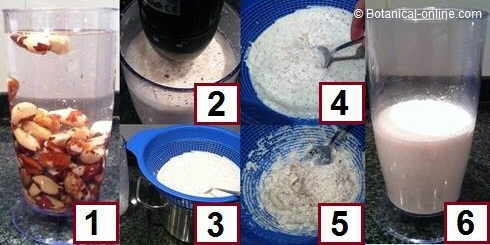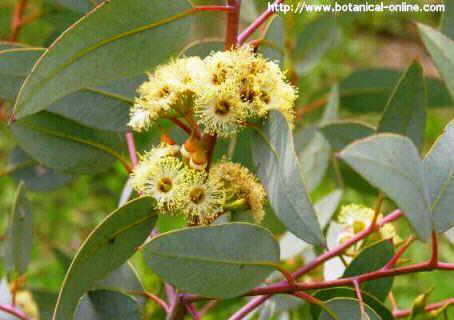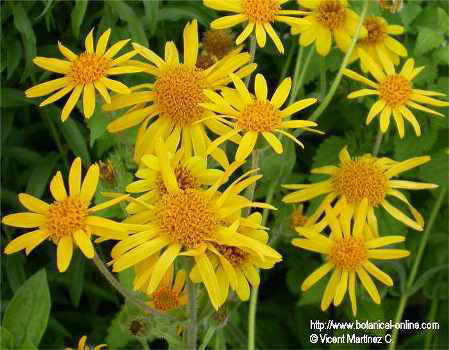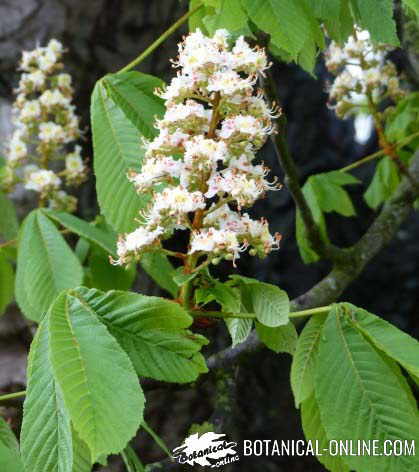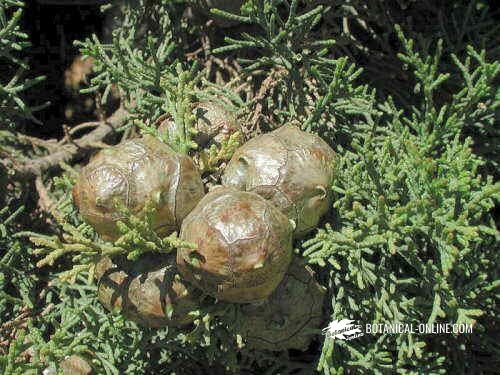Contents
- 1 Thickened root and stem types
- 1.1 Characteristics and properties of tubers
- 1.2 What are tubers?
- 1.3 What are tubers for?
- 1.4 Development of a plant with tubers
- 1.5 TUBERS CONSUMED IN FOOD
- 1.6 Main plants with edible tubers
- 1.7 Yam, the most cultivated tuber in the world
- 1.8 Potato plant
- 1.9 Other edible tubers used in food
- 1.10 THE TUBE ROOTS
- 1.11 What are tuberous roots?
Thickened root and stem types
Characteristics and properties of tubers
What are tubers?
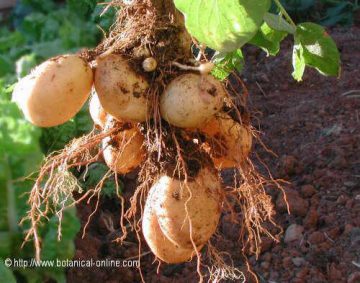
Tubers are a type of thickened stems that certain plants have. In tubers, these plants accumulate reserve substances, consisting mainly of starch.
Tubers are generally underground and contain a series of scales (called “germ” in the case of potatoes) that produce buds.
From these buds, new shoots or stems develop that will give rise to new plants.
The underground shoots, when they go outside, turn green producing green stems and leaves, which is the vegetative part of the plant. The tubers develop roots.
What are tubers for?
The tubers serve as the plant’s energy reserve. The plant uses the energy found in them to produce leaves, branches and new structures.
Potato tuber drawing | PARTS OF TUBERS 1 – Thickened stems 2 – Germs of the potato that will produce buds 3 – Roots that develop underground stems 4 – From the buds new shoots or stems are developed that will originate new plants. |
Development of a plant with tubers
From one of the tuber buds a plant can be produced. For example, by planting a potato with a bud, you can grow a plant from it. This is because, while the plants are growing, they feed on the original tuber until they completely deplete it and decompose it. As the plant grows, it develops more roots, which in turn produce more tubers.
The new plants, when they develop green leaves and stems, manage to produce starch and other reserve substances such as inulin that they will later store in new tubers produced in the internodes.
The external part of the plant, as it produces energy for the production of tubers, leaves and fruits and seeds is depleted and dies, leaving the tubers as a reserve underground.
TUBERS CONSUMED IN FOOD
Main plants with edible tubers
After potatoes, the most cultivated tubers in the world are, in order of importance: cassava, sweet potato, yam and taro.
Yam, the most cultivated tuber in the world
 Yam (Dioscorea alata): The species of yam most cultivated worldwide is the water yam, which is characterized by a white, yellow or purple pulp. The water yam is consumed mainly in the American continent and in South Asia.
Yam (Dioscorea alata): The species of yam most cultivated worldwide is the water yam, which is characterized by a white, yellow or purple pulp. The water yam is consumed mainly in the American continent and in South Asia.
It is known that this variety has been cultivated since ancient times, so its consumption is deeply rooted in the tradition of many peoples).
Potato plant
- Potato (Solanum tuberosum): The main edible tuber in the world is the potato. Potato is an herb of the Solanaceae family up to 130 cm high. Pinnate leaves with ovate or cordate leaflets. White or purple flowers, up to about 4 cm in diameter, with very prominent yellow anthers.
The fruit is a berry, black and toxic, like the rest of the plant. It is native to America, but it is cultivated all over the world and many times grows naturalized on roadsides, piles of earth and places very rich in organic waste.
Potato is one of the most widely cultivated plants in the world. Being toxic in its external part, it constitutes one of the main food resources due to its richness in starch, accumulated in its underground tubers (also called potatoes).
These are formed in the internodes, can appear up to about 20 and reach a very variable size depending on the variety and growing conditions. Potatoes are the only edible part of the plant.
Other edible tubers used in food
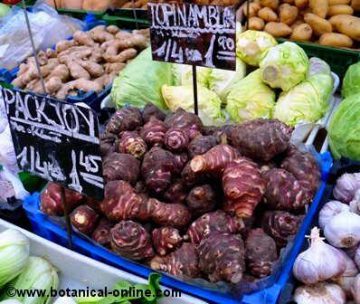
- Sweet potatoes (Ipomoea batatas): They are creepers of the convolvulaceae family, among which are some herbs known as bluebells. Among the garden plants belonging to this family, the best known is another vine called blue morning glory (Ipomoea acuminata). Sweet potatoes produce edible tubers that are brown in color with yellowish pulp, because they contain many carotenes.
In addition to being used in human food, they are used in some nations like China, the world’s main producing country, to feed livestock and domestic animals. It is also used to obtain starch for industries. It comes from Peru and is grown in many parts of the world that have a warm climate.
- Tigernuts (Cyperus sculentus): they are a type of canes that produce tubers in their underground stems. The tubers of tigernuts are small and contain a very sweet pulp that is used to make a drink called horchata. It is grown in few places in the world, the most famous being the tigernuts from Valencia, in Spain.
- Jerusalem artichoke (Helianthus tuberosus) is a type of American sunflower whose common name, like that of the potato, comes from the fact that it has tubers that in both cases are edible.
- Taro (Colocasia esculenta): It is a tropical plant whose subterranean tuber is eaten once cooked because raw it is very toxic.
THE TUBE ROOTS
What are tuberous roots?
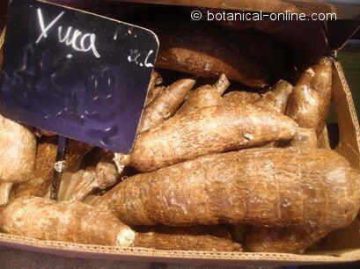
Tuberous roots are thickened roots. Tubers must be distinguished from tuberous roots as in dahlia, in which the thickened subterranean part is a root and not a stem. In practice it is quite difficult to distinguish a tuber from a tuberous root.
- Cassava (Manihot esculenta = Manihot utilissima): As an example of an edible tuberous root we have cassava, which is also known as yuca, manioc, mandioca or macaxeira.
It is a plant with tuberous roots of the euphorbiaceae family, to which belong such well-known herbs such as spurges (Euphorbia ssp.), Gardening flowers as widespread as poinsettia (Euphorbia pulcherrima) and other shrubs like for example castor bean (Ricinus communis).
Cassava is a perennial shrub between 1 and 3 meters high. Slender stems that show the scars of its previous leaves. Its leaves, located in the upper part of the stems, are palmate-lobed, they can present up to 9 lobes and are somewhat reminiscent of those of castor bean.
What stands out the most about this plant are its huge tuberous roots in number of 5 to 10 per plant. These can reach up to 1.2 meters in length and up to 23 cm in diameter.
From these roots, which are very rich in starch, a flour (“tapioca flour”) is obtained, which is the main ingredient in the production of many dishes and beverages.
![]() More information on types of roots and stems
More information on types of roots and stems

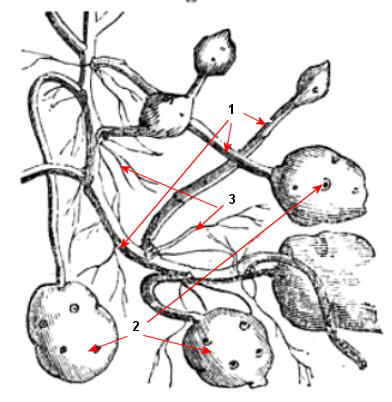
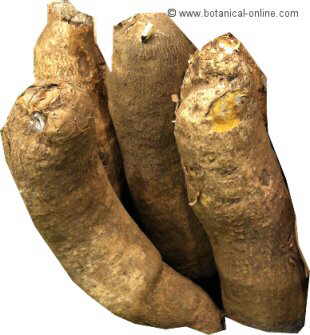 Yam (Dioscorea alata): The species of yam most cultivated worldwide is the water yam, which is characterized by a white, yellow or purple pulp. The water yam is consumed mainly in the American continent and in South Asia.
Yam (Dioscorea alata): The species of yam most cultivated worldwide is the water yam, which is characterized by a white, yellow or purple pulp. The water yam is consumed mainly in the American continent and in South Asia.